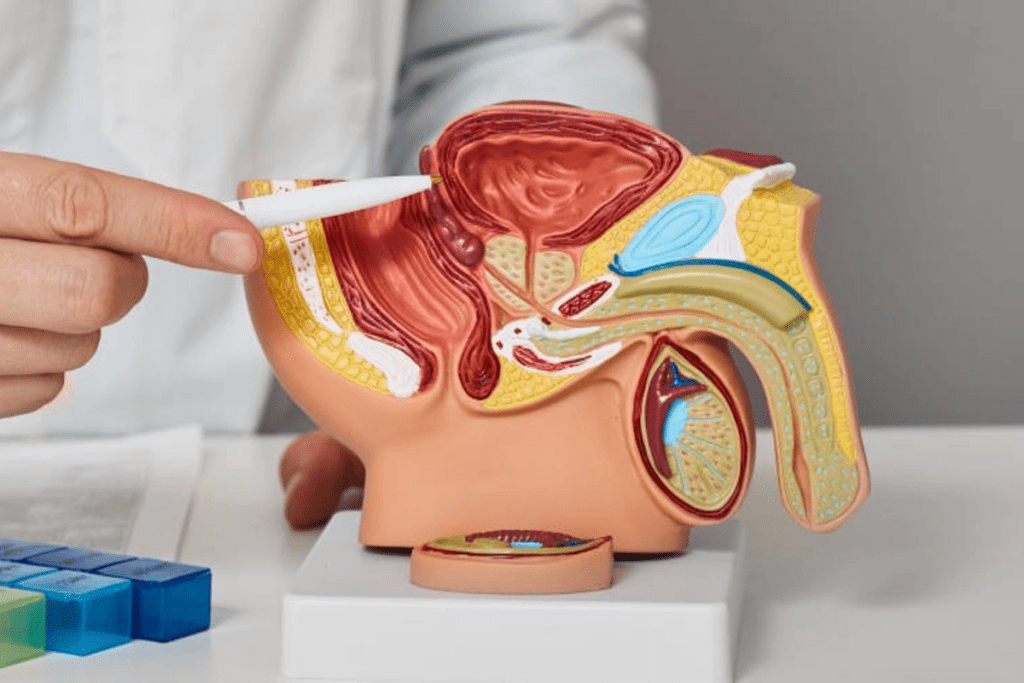Last Updated on October 31, 2025 by
Research shows that walking daily can greatly improve prostate health. It may not shrink the prostate, but it helps lower the risk of benign prostatic hyperplasia (BPH). It also eases symptoms related to BPH.

Studies reveal that men who walk 2“3 hours a week face a 25% lower risk of BPH. Adding three more hours of walking each week can cut this risk by an extra 10%. This highlights the vital role of exercise in keeping the prostate healthy.Learn how regular activity like walking can help maintain a fit prostate and reduce the risk of enlargement.
Prostate enlargement, or benign prostatic hyperplasia (BPH), is common among men. It happens as men get older. The prostate gland grows, affecting how well you can urinate.

The exact reason for BPH is not known. But, hormonal changes with age are thought to play a big part. The conversion of testosterone to dihydrotestosterone (DHT) is key. DHT makes prostate cells grow more.
Doing prostate exercises might help with symptoms. Hormones, lifestyle, and genetics all matter too.
Symptoms of BPH can vary. They often include:
Exercises for BPH can help. For example, Kegel exercises strengthen muscles around the prostate. This can improve how well you can urinate.
BPH is common in older men. Harvard Health Publishing says active men are less likely to get it. This shows that being active can lower the risk of BPH.
Other risk factors include getting older, family history, being overweight, and not being active. Knowing these risks and taking steps like exercises for BPH can help manage it.
Exploring the link between walking and prostate health reveals interesting facts. We learn how walking can affect prostate size and overall health.

Studies on walking’s direct effect on prostate size are ongoing. Some research suggests walking can improve prostate health. Yet, the proof for shrinking prostate size is growing slowly.
A study in the Journal of Urology showed men who walked briskly for three hours weekly were 57% less likely to see their prostate cancer progress. This shows walking’s benefits for prostate health.
“Regular physical activity, like walking, improves health in men with prostate issues,” says a leading researcher.
Walking’s indirect benefits for prostate health are clearer. It helps keep a healthy weight, improves blood flow, and lowers inflammation. These factors contribute to better prostate health.
Regular walking also boosts overall fitness. This includes exercises for prostate health.
These benefits help keep the prostate healthy. They may also reduce symptoms of an enlarged prostate.
Despite encouraging results, research has its limits. Many studies rely on self-reported data, which can be biased. The definition of “regular walking” varies, making it hard to set a standard for exercise to shrink prostate.
Future studies should use more reliable measures of physical activity and prostate health.
Walking is a simple yet effective way to reduce the risk of BPH. Research shows a 25% lower risk for men who walk 2-3 hours weekly. This highlights the importance of physical activity in our lives.
The Health Professionals Follow-up Study found a big decrease in BPH risk for men who walk 2-3 hours weekly. You can achieve this by brisk walking, walking to work, or adding short walks to your day.
More walking can lead to an additional 10% risk reduction in BPH. This shows that longer walks are linked to more risk reduction. So, the more you walk, the better your chances of avoiding BPH.
The ways walking reduces BPH risk are complex. They include better insulin sensitivity, less inflammation, and healthier hormone levels. Walking also boosts blood flow and may lower oxidative stress, helping your prostate stay healthy.
To get the most from walking for prostate health, having a regular routine is key. We’ll show you how to set up a good walking plan.
The American Cancer Society says you should do at least 150 minutes of moderate exercise weekly. For prostate health, break this into smaller parts. Try:
Being consistent is important. Even short walks help if you’re starting out. The goal is to find a pace you can keep up with.
Walking intensity is important for prostate health. Moderate walking is good, but brisk walking offers more benefits. Here’s what to consider:
For the best results, mix both moderate and brisk walks. This keeps your walks interesting and prevents getting stuck in a routine.
How often you walk is as important as how long or how hard you walk. For the best prostate benefits, follow these frequency tips:
By choosing the right duration, intensity, and frequency, you can make a walking plan that’s good for your prostate and overall health. Remember, consistency is key, so pick a routine you can stick to.
Walking can help with urinary symptoms in Benign Prostatic Hyperplasia (BPH). It’s key to know how walking can ease urinary issues and boost prostate health.
Men with BPH often face lower urinary tract symptoms (LUTS). These symptoms can be uncomfortable and disrupt daily life. A study in the Journal of Urology showed walking helps improve LUTS in men with BPH.
The symptoms lessen because of better blood flow and less inflammation. These benefits come from regular physical activity, like walking.
Walking can make it easier for men with BPH to manage their symptoms. Regular walking strengthens the pelvic floor muscles. These muscles are key for controlling urine.
By making these muscles stronger, walking improves urine flow and reduces the need for frequent bathroom visits.
“Physical activity, such as walking, can have a significant impact on urinary symptoms in men with BPH, improving quality of life.”
Nocturia and urgency are common BPH symptoms that can be upsetting. Walking can help by improving bladder control and reducing nighttime urination. By walking daily, men with BPH can feel less urgency and have a more stable bladder.
Walking offers many benefits for men with BPH. It improves symptoms like LUTS, reduces nocturia, and eases urgency. Understanding walking’s impact on urinary symptoms helps men with BPH manage their condition and enhance their quality of life.
To get the most out of walking for prostate health, add some extra exercises to your routine. Certain exercises can help with enlarged prostate symptoms and boost your overall health.
Kegel exercises are easy and effective for strengthening the pelvic floor muscles. This can help with urinary issues in men with Benign Prostatic Hyperplasia (BPH). Here’s how to do Kegel exercises:
Benefits of Kegel Exercises: They can improve bladder control, reduce how often you need to urinate, and boost prostate health.
There are more exercises that support prostate health, aside from Kegel exercises. These include:
While exercise is good, some activities might make BPH symptoms worse. It’s important to steer clear of:
By walking and doing these exercises, and avoiding harmful activities, men with BPH can manage their symptoms better. This can improve their prostate health overall.
New studies show that walking can greatly reduce prostate cancer risk. We’ll look at how walking affects prostate cancer risk. This includes its impact on PSA levels and its role in treatment.
A study in the Journal of Clinical Oncology found a big benefit. Men who walked briskly for three hours a week had a 57% lower risk of prostate cancer progression. This shows walking’s value in managing prostate cancer.
To get these benefits, we suggest:
Walking can also improve Prostate-Specific Antigen (PSA) levels. These levels are important for prostate health. Regular walking can help keep PSA levels healthy, lowering cancer risk.
For those with prostate cancer, walking is a great complementary therapy. It helps manage treatment side effects and boosts overall health and mood. We advise talking to your doctor about adding walking to your treatment plan.
Important things to remember include:
By walking regularly, men can play a big part in managing their prostate health. This can help lower cancer risk.
To get the most out of walking for prostate health, think about making other lifestyle changes. Walking is great for your health, but adding other healthy habits can help even more.
Eating lots of fruits, vegetables, and whole grains is good for your prostate. Adding foods high in antioxidants, like berries and leafy greens, can fight off oxidative stress. Also, eating foods with omega-3 fatty acids, like salmon, is good for your health.
Try to eat less processed meats and dairy. These foods might increase the risk of prostate problems. Eating a balanced diet with lots of nutrient-rich foods can support your prostate.
Drinking enough water is key for health, but you need to drink it right to avoid bad urinary symptoms. Drink water all day to stay hydrated without overloading your bladder.
Don’t drink too much water at night to avoid waking up to pee. Watch how much caffeine and alcohol you drink too. These can make your bladder upset and worsen symptoms.
Stress can hurt your prostate health, so managing stress is important. Try meditation and deep breathing to lower your stress levels.
Doing relaxing activities like yoga or tai chi can also help. Make these activities part of your daily routine to boost the benefits of walking for your prostate.
Regular physical activity, like walking, is key for long-term prostate health. Adding walking to your daily routine can help lower the risk of BPH. It also improves urinary symptoms.
To keep your prostate fit, aim for 2-3 hours of brisk walking each week. You can do this in shorter sessions. Adding prostate exercises, like Kegel exercises, can strengthen your pelvic floor. This helps with better urinary function.
Making walking a regular part of your life is a great step towards a healthy prostate. We suggest talking to a healthcare professional. They can help create a plan that includes walking and other lifestyle changes for you.
Walking doesn’t shrink the prostate directly. But, it helps prostate health in other ways. It can lower the risk of benign prostatic hyperplasia (BPH) and improve urinary symptoms.
Walking can cut BPH risk by 25% with 2-3 hours a week. More walking means more benefits. It also helps with urinary flow, frequency, and reduces nighttime and urgent urination.
Aim for 2-3 hours of walking a week. It should be at a moderate to brisk pace. You can split this into 30 minutes a day, five days a week.
Yes, Kegel exercises strengthen pelvic floor muscles. This can improve urinary symptoms and prostate health. Adding Kegels to your routine, along with walking, is a good idea.
Yes, heavy lifting or bending can make BPH symptoms worse. Stick to low-impact activities like walking and Kegel exercises instead.
Walking may lower prostate cancer risk by 57% in early stages. It can also lower PSA levels and improve health during treatment.
Eat a balanced diet with fruits, veggies, and whole grains. Avoid processed meats and foods high in sugar and saturated fats.
Drinking enough water is key, but don’t drink too much before bed. This can help avoid nighttime urination. Spread out your water intake during the day.
Yes, stress reduction like meditation and deep breathing can help. They reduce stress and support prostate health. Add these to your routine, along with walking and healthy habits.
Brown University Health. (2024). The role of diet in prostate health. Retrieved from https://www.brownhealth.org/be-well/role-diet-prostate-health
Cancer Research UK. (n.d.). Physical activity, weight and prostate cancer. Retrieved from https://www.cancerresearchuk.org/about-cancer/prostate-cancer/practical- emotional-support/physical-activity
Subscribe to our e-newsletter to stay informed about the latest innovations in the world of health and exclusive offers!